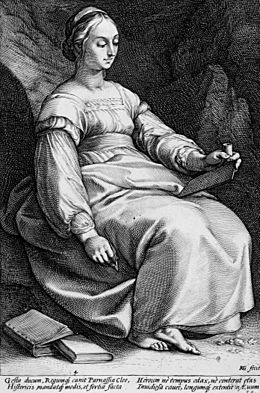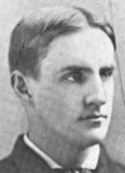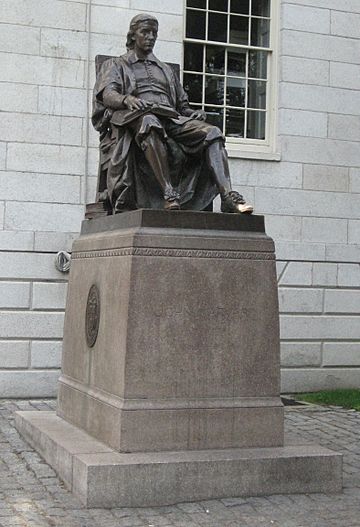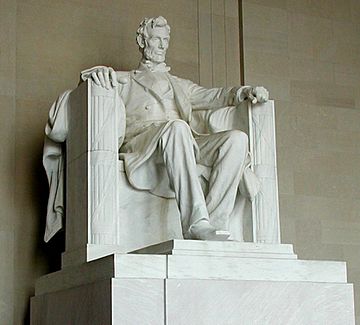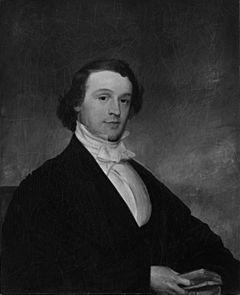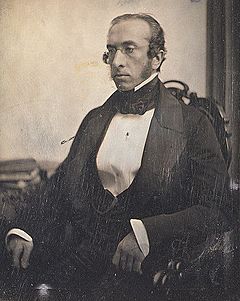Statue of John Harvard facts for kids
Quick facts for kids John Harvard |
|
|---|---|
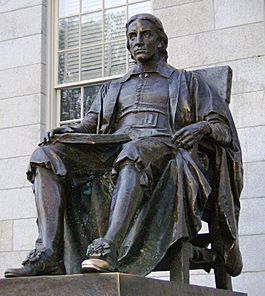
"He gazes for a moment into the future, so dim, so uncertain, yet so full of promise, promise which has been more than realized."
|
|
| Artist |
|
| Year | 1884 |
| Type | Bronze |
| Dimensions |
|
| Location | Harvard Yard, Cambridge, Massachusetts |
The John Harvard statue is a bronze statue created by Daniel Chester French. It stands in Harvard Yard in Cambridge, Massachusetts. The statue honors John Harvard (1607–1638). He was a clergyman whose gift helped start Harvard.
John Harvard gave money and books to the college. This happened soon after the Massachusetts Bay Colony began the school. Because of his generous gift, the school was named Harvard College.
No one knew what John Harvard looked like. So, Daniel Chester French used a Harvard student as his model. This student was related to an early Harvard president.
The statue's inscription says: "JOHN HARVARD • FOUNDER • 1638". People often debate if John Harvard was truly "the" founder. Harvard officials say many people helped found the college. John Harvard is seen as "a" founder, not "the" founder. His gift was very important and given at the right time. This makes him the most honored founder.
Many tourists rub the toe of John Harvard's left shoe for good luck. They think this is a Harvard student tradition. However, it is not a real student tradition.
Contents
What the Statue Looks Like
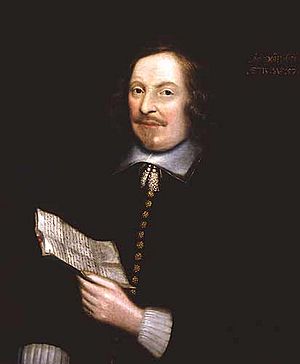
When the statue was first shown, The New York Times described it. The young clergyman is sitting with an open book on his lap. He wears simple 17th-century clothes. These include low shoes, long silk stockings, loose pants, and a tunic. A long cloak is draped over him.
John Harvard is also wearing a skullcap. This is a small, close-fitting cap. Many people do not notice this detail. Other small details include a slight mustache and tassels on his collar. His shoes have "roselike decorations."
John Harvard gave the school £780 and his library. His library had 400 books. A pile of books is shown under his chair, easy to reach.
At the time the statue was made, people knew John Harvard had died young. He was about 30 years old and had a serious illness. This information helped French decide how to show him. French's model for the statue (except the face) was a young English man. He was an Oxford graduate who needed money.
Historian Laurel Ulrich thinks the statue's design might be from an old engraving. This engraving was of Clio, the muse of history. She also suggests that details like the collar and mustache might come from a portrait of Edward Winslow. Winslow was a governor of Plymouth Colony.
How the Statue Was Made
On June 27, 1883, a letter was read at a Harvard alumni dinner. It was from a generous donor, General Samuel James Bridge. He offered to pay for a bronze statue of John Harvard. He wanted Daniel Chester French to design it. Bridge said the statue could be ready by June 1, 1884.
Bridge asked for an "ideal" statue. This was because no one knew what John Harvard looked like. So, French began work in September. He used Harvard student Sherman Hoar as his model for the face. French said Hoar had the look he wanted for early settlers. Sherman Hoar was related to an early Harvard president.
Making the statue was a big task for French. He later created the famous Abraham Lincoln statue for the Lincoln Memorial. French's final model was ready in May. The Henry-Bonnard Bronze Company then made it into bronze. The statue reportedly cost over $20,000.
The statue was first placed west of Memorial Hall. Harvard president Charles William Eliot said it looked "wistfully into the western sky." It was shown to the public on October 15, 1884.
In 1920, French wanted the statue moved. In 1924, it was moved from Memorial Hall. It now stands on the west side of Harvard Yard's University Hall. It faces other important Harvard buildings.
Around the 1990s, tour guides started telling visitors to rub the statue's toe for luck. This was not a real student tradition. Because of this, the toe is now shiny from all the rubbing.
It is a tradition for graduating students to remove their caps. They do this as they walk past the statue on Commencement Day.
The statue is also shown on a United States postage stamp. This stamp was part of the "Great Americans series" in 1986.
Statue Details and Inscriptions
The facts as to John Harvard's relation to the founding of the College are entirely compatible with the inscription on John Harvard's statue. There is no myth to be destroyed.
The statue stands on a six-foot granite base, called a plinth. This base was designed by Boston architect Charles Howard Walker.
- On the right side of the plinth, there is a bronze seal. This is the seal of Emmanuel College, John Harvard's old school.
- On the left side, there is the seal of Harvard College. This seal shows three open books and the word "veritas," which means "truth."
On the back of the plinth, it says: "GIVEN BY • SAMUEL JAMES BRIDGE • JUNE 17, 1883".
The front of the plinth has these words: "JOHN HARVARD • FOUNDER • 1638". People often joke that this is the "Statue of the Three Lies." This is because:
- The statue is not a real picture of John Harvard.
- Harvard College was started in 1636, not 1638. The year 1638 is when John Harvard made his gift.
However, many people, including Harvard officials, say these "lies" are not really false. They explain that:
- The statue is an "ideal" image. It shows what John Harvard might have looked like.
- While the college was officially voted into existence in 1636, John Harvard's gift in 1638 was very important. It helped make sure the college would last. Because of his gift, the college was named after him.
So, the inscription is seen as true to the spirit of John Harvard's role.
Pranks and Vandalism
The statue has been the target of pranks since it was first put up.
Early Incidents
In 1884, The Harvard Crimson newspaper reported that someone covered the statue with tar. They also wrote "87" on a chapel wall. In 1886, the Crimson mentioned another incident where the statue was painted.
1890 Painting Incident
After a Harvard sports victory in May 1890, the statue was painted red. College buildings were also marked. Newspaper headlines called it "Vandalism at Harvard." They said students had "daubed with red paint."
Detectives looked into the incident. They found impressions in the wet paint. Some thought they were dog paws, others thought they were barefoot boys. Newspapers across the country reported on the event. They described "disgraceful antics" and "rum-crazed students."
Despite efforts to find the culprits, no one was officially caught.
Creating an "Ideal" Statue
Creating a statue of John Harvard was a challenge. No one knew what he looked like. So, the artist had to create an "ideal" image.
George Edward Ellis, who spoke at the statue's unveiling, talked about this. He said the artist had to use hints to create a graceful and dignified image. He noted that it's hard to make a statue of someone when you don't know their features.
However, Robert Charles Winthrop, a historian, disagreed. He thought making a statue without a real image was a "fancy sketch." He worried it would confuse history. He felt it was wrong to create a fake likeness.
A year later, Ellis responded to this criticism. He said the bronze statue serves a purpose. It helps people see and feel the idea of John Harvard, even without a real image. He compared it to poetry, where artists can add "finer touches." He said it's okay to make an ideal image when a real one doesn't exist.
Ellis even joked that if a real picture of John Harvard ever appeared, someone generous would melt the statue down. Then, they would make a new one that showed the "whole known truth."


